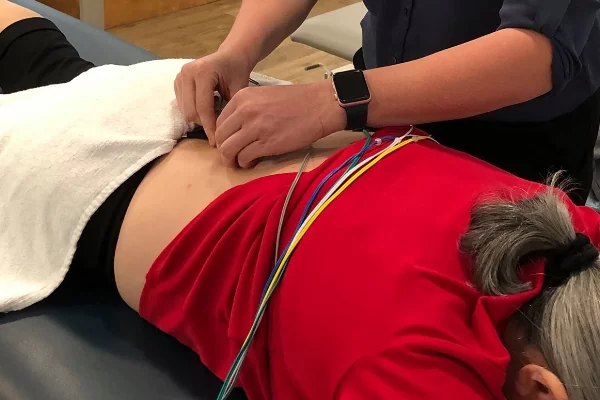Kinesio Taping
Kinesio Taping for Injuries and Chronic Pain
Kinesio tape is most frequently used by athletes—especially those who engage in prolonged activities. Runners especially are drawn to kinesio taping, as the technique is incredibly low-profile and unlikely to get in the way of their running stride. However, kinesio tape can benefit many people outside of the athletic world, and certainly stretches beyond supporting runners. Those who experience wrist pain after typing all day, or who experience back pain due to their job may also benefit from utilizing kinesio tape.
Common conditions our trained physical therapists often treat with kinesiology taping include:
- Back sprains and strains
- Neck aches
- Shoulder injuries
- Knee pain
- Sports injuries
Kinesio taping has become much more visible in recent years. You have likely seen athletes, gym-goers, and even pregnant women using the colorful muscle tape in strategic positions as a way of easing pressure on their joints and alleviating pain. Kinesio tape is a union of old-school pain management strategies and state-of-the-art medical technology, utilizing aspects of acupressure and strategic physical therapy by placing elastic therapeutic tape around problematic areas. The tape exudes a pulling force, allowing for free range of motion while still providing a therapeutic pressure to the targeted area.
While using tape to wrap injured areas is not inherently new, the use of kinesio tape is different. Kinesio tape is specialized to react to body heat, providing added support by staying firm and in-place all day. While traditional bandages have long been used to provide additional support during injury recovery, kinesio tape is the first of its kind. This type of kinesiology tape can be purchased through your physical therapist or at a local sport goods store, and comes in a roll of tape in a variety of colors. The tape is cut to fit the area in need of reinforcement, and lasts all day. Unlike a standard ACE bandage, that will typically wear over time and not be as effective with later uses, the Kinesio tape is one-time use and designed to last all day—sometimes even longer!
The acrylic adhesive component in kinesiology tape is activated by body heat, meaning that as soon as your physical therapist applies the taping system, it will begin working. Yet the cotton fibers that also comprise the material wick moisture away. That means that sweating and getting the area wet isn’t as much of an issue as it was with traditional bandages injured athletes and other patients were once given.
Many pregnant women are also using this method of athletic taping, especially for their back, knees, and even lower abdominal muscles during the third trimester to alleviate some of the additional pressure on the body during pregnancy. Ensure that you talk with a physical therapist for guidance before attempting to use athletic taping for any reason, but especially before taking any action for pain relief when pregnant.
What is the science behind kinesiology taping?
The goal of kinesio tape is to enhance blood circulation at targeted areas, thereby reducing pain and improving recovery time following an injury. Kinesio tape works off the science of kinesiology, which is a fundamental aspect of physical therapy. The taping creates a pulling action that helps to hold problematic joints and muscles in place as you go about your daily business and routine—including engagement in any level of physical activity or exercise.
The tape works by gently reinforcing the skin, pulling it away from your muscles, thereby allowing blood and other fluids to circulate more easily. The gentle pressure also cues the body to send additional blood to the taped area. This improved circulation lessens swelling and speeds healing. Some evidence suggests that the tape’s exceptional holding abilities also help to correct misaligned muscles and ligaments.
For kinesio tape to work effectively, the tape must be applied in strategic ways. Simply putting a bit of tape on your leg or elbow isn’t going to make much of a difference. However, when a physical therapist applies the tape in a strategic way that it is designed to follow muscle movement as you move through your day, then the tape can effectively improve healing and reduce pain.
The best wrapping technique changes depending on the part of the body in need of attention. Physical therapists are trained in the best ways to tape different parts of the body. Determining the exact placement and shaping of the kinesiology tape, along with which direction the “pull” should go, are all part of the skill needed in order to promote healing. For example, certain injuries call for Y- or X-shaped applications, while smaller, more fragile areas heal better with an I-shaped wrapping. Attempting to apply the tape yourself, without any guidance, could result in further discomfort. It is important to receive guidance and training from a physical therapist when first applying kinesio tape.
When properly applied — and after the patient has been carefully evaluated — muscle taping often allows athletes to get back on the field. Other injured patients find their daily activities made easier, with the support of the taping holding tender areas in place, and preventing overuse of problematic joints and muscles.
If any of these complaints sound similar to yours, Contact Us Today at Covington & Mandeville, LA Centers for an appointment. Our expert team will evaluate you for the best therapies, including kinesiology taping, to target your injuries.





